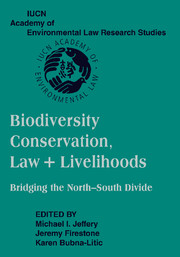 Biodiversity Conservation, Law and Livelihoods: Bridging the North-South Divide
Biodiversity Conservation, Law and Livelihoods: Bridging the North-South Divide Book contents
- Frontmatter
- Contents
- Acknowledgments
- Message from Kofi A. Annan, Secretary-General of the United Nations
- Macquarie Statement
- Contributors
- Introduction
- PART ONE THE CONTEXT
- PART TWO BIODIVERSITY: ITS CONSERVATION
- PART THREE CONSERVATION MEASURES
- PART FOUR USES OF COMPONENTS OF BIODIVERSITY
- PART FIVE PROCESSES AFFECTING BIODIVERSITY
- 20 Biodiversity and Climate Change Laws: A Failure to Communicate?
- 21 Emissions Trading: A Fantasy for China to Combat Global Warming?
- 22 A Brief Historical Comparison of the Public Land Disposal Policies in Brazil and in the United States
- 23 Protecting Ecological Functions: Ecological Function Zoning and Conservation Zones in the PRC
- 24 The Successful Ecograss Project and the Policy and Legal Issues Met and Solved
- PART SIX BIOSECURITY ISSUES
- PART SEVEN ACCESS AND BENEFIT-SHARING
- Index
20 - Biodiversity and Climate Change Laws: A Failure to Communicate?
Published online by Cambridge University Press: 31 July 2009
- Frontmatter
- Contents
- Acknowledgments
- Message from Kofi A. Annan, Secretary-General of the United Nations
- Macquarie Statement
- Contributors
- Introduction
- PART ONE THE CONTEXT
- PART TWO BIODIVERSITY: ITS CONSERVATION
- PART THREE CONSERVATION MEASURES
- PART FOUR USES OF COMPONENTS OF BIODIVERSITY
- PART FIVE PROCESSES AFFECTING BIODIVERSITY
- 20 Biodiversity and Climate Change Laws: A Failure to Communicate?
- 21 Emissions Trading: A Fantasy for China to Combat Global Warming?
- 22 A Brief Historical Comparison of the Public Land Disposal Policies in Brazil and in the United States
- 23 Protecting Ecological Functions: Ecological Function Zoning and Conservation Zones in the PRC
- 24 The Successful Ecograss Project and the Policy and Legal Issues Met and Solved
- PART SIX BIOSECURITY ISSUES
- PART SEVEN ACCESS AND BENEFIT-SHARING
- Index
Summary
INTRODUCTION
Climate change driven by global warming is threatening to substantially modify important ecosystems, both marine and terrestrial, because the rate of climate change exceeds rates at which ecosystems and the biodiversity they contain can adapt or migrate. Global warming threatens to destroy great swaths of biodiversity within affected ecosystems. Preservation of biodiversity and avoidance of catastrophic ecosystem collapse depend on global success in reducing emissions of greenhouse gases and stabilizing (or, hopefully, reducing) atmospheric green house gas concentrations. For lawyers, the challenge is how law can be used to achieve this goal.
Two separate sets of laws exist – laws concerning biodiversity and endangered species (e.g., the United Nations Convention on Biological Diversity [CBD], and the U.S. Endangered Species Act [ESA] and comparable laws in other countries) and emerging laws addressing greenhouse gas emissions. Both bodies of law mirror the same analytic questions. That is, to what extent do national and international biodiversity laws consider climate change in their regulatory frameworks? And, to what extent does the emerging climate change legal regime consider biodiversity in its regulatory schemes? Is the extent of incorporation adequate and effective? If not, how could laws be improved to incorporate biodiversity concerns into climate change decisions, and to fold climate change concerns into the operation of biodiversity laws?
- Type
- Chapter
- Information
- Biodiversity Conservation, Law and Livelihoods: Bridging the North-South DivideIUCN Academy of Environmental Law Research Studies, pp. 383 - 399Publisher: Cambridge University PressPrint publication year: 2008
